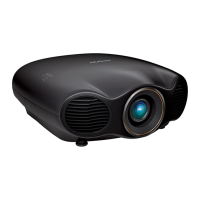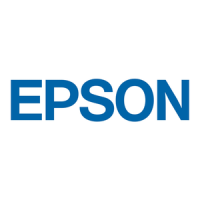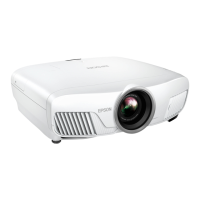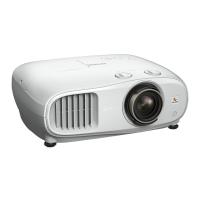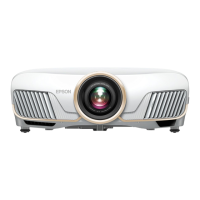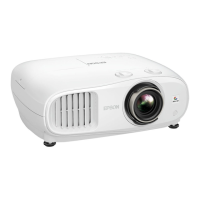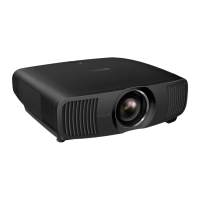
Do you have a question about the Epson Pro Cinema LS12000 and is the answer not in the manual?
| Display Technology | 3LCD |
|---|---|
| Resolution | 4K PRO-UHD (3840 x 2160) |
| Contrast Ratio | 2, 500, 000:1 |
| Light Source | Laser |
| Light Source Life | Up to 20, 000 hours |
| Lens Shift | Vertical: ±96.3%, Horizontal: ±47.1% |
| HDR Support | HDR10, HLG |
| Throw Ratio | 1.35 - 2.84:1 |
| Color Gamut | 100% of DCI-P3 |
| 3D Support | Yes |
| Wireless Connectivity | No |
| Brightness | 2700 Lumens |
| Ports | USB, RS-232C, LAN |
| Keystone Correction | Vertical |
| Zoom Ratio | 1 - 2.1x (Optical) |
| Input Lag | Approx. 20ms (4K/60Hz) |
| Noise Level | 22 dB (Eco), 24 dB (Normal) |
| Warranty | 2-year limited warranty, 90-day lamp warranty |
Details the projector's key features including resolution, connectivity, and ease of use.
Lists all items included in the projector's packaging for setup and initial use.
Information on optional components that may be needed for specific setup configurations.
Guidance on purchasing accessories and replacement parts for the projector.
Details regarding product warranty coverage and registration procedures.
Explains the meaning of symbols and conventions used throughout the manual.
Provides resources for obtaining further help and information about the projector.
Identifies the physical parts and ports on the projector.
Guidance on selecting a suitable location and mounting the projector for optimal performance.
Outlines different methods for setting up and installing the projector, including mounting.
Explains how projector distance affects image size and provides reference tables.
Details how to connect various video sources and external devices to the projector.
Instructions for managing projector cables using the provided cover for a neat installation.
Step-by-step guide on how to insert batteries into the projector's remote control.
Steps to establish a wired network connection for projector control and monitoring.
Guide to configuring network settings on the projector for remote operation.
Instructions for powering on the projector and initial checks.
Procedures for safely shutting down the projector after use.
How to change the display language for the projector's user interface.
Using adjustable feet to correct the vertical position of the projected image.
Using the lens shift feature to fine-tune the image's horizontal and vertical position.
Manually correcting horizontal and vertical image shape distortions using keystone.
Correcting image shape and alignment for all sides using an on-screen display.
Fine-tuning image shape by adjusting specific points on a grid for precise distortion correction.
Adjusting the projected image size using the optical zoom functionality.
Fine-tuning the projected image clarity using the focus adjustment.
Guidelines for using the remote control effectively within its range and angles.
How to switch between different connected video or computer sources.
Adjusting the image orientation based on projector placement (front, ceiling, rear).
Changing the width-to-height ratio of the displayed image for optimal fit.
Selecting predefined color modes to optimize image appearance for different environments.
Fine-tuning image detail by adjusting the sharpness levels.
Controlling the overall brightness of the projected image.
Optimizing image contrast by automatically adjusting luminance based on content.
Fine-tuning the overall color tone by adjusting the balance between red and blue tints.
Adjusting brightness of dark and bright areas for individual colors (RGB).
Correcting image color differences between sources by adjusting gamma values.
Fine-tuning individual color components (hue, saturation, brightness) for accurate color reproduction.
Controlling connected HDMI devices using the projector's HDMI Link (CEC) functionality.
Temporarily blanking the projected image without stopping video playback for presentations.
Options to secure the projector against unauthorized use or theft.
Exploring advanced settings for image enhancement and customization.
Saving and recalling custom projector image and lens position settings.
Transferring projector configuration settings to another unit for faster setup.
Navigating the projector's on-screen menu system for configuration.
Adjusting core image parameters like brightness, contrast, color, and sharpness.
Configuring how the projector handles incoming video signals and formats.
Settings related to projector placement and image geometry correction.
Customizing display features like startup screens and no-signal behavior.
Configuring operational features such as power, sleep mode, and indicators.
Accessing administrative settings like security locks, language, and system information.
Setting up network connectivity for remote control and monitoring.
Managing saved image quality presets and lens positions.
Resetting projector settings to defaults and updating firmware.
General guidance on keeping the projector in optimal condition.
Instructions for safely cleaning the projector's optical lens to maintain image clarity.
Procedures for cleaning the projector's exterior casing.
Importance and steps for cleaning or replacing the air filter for proper ventilation.
Procedures for updating the projector's internal software via USB or computer.
Guidelines for safely moving or shipping the projector to prevent damage.
Basic troubleshooting steps for common projector operational issues.
Interpreting the status and error indicator lights on the projector.
Steps to take when the projector fails to display any image.
Troubleshooting steps for resolving the "No Signal" error message.
Setting up a PC laptop to display on an external monitor.
Setting up a Mac laptop for mirrored display on an external monitor.
Steps to fix issues where only a portion of the image is displayed.
Methods to correct geometric distortion and ensure a rectangular image.
Troubleshooting steps for interference, noise, or static in the projected image.
Steps to improve image clarity when it appears fuzzy or out of focus.
Troubleshooting for issues with incorrect image brightness or color reproduction.
Steps to resolve synchronization issues between the projected image and audio.
Troubleshooting steps for audio-related issues such as no sound or incorrect volume.
Guides for resolving operational issues with the projector or its remote.
Troubleshooting steps for power-on failures or unexpected shutdowns.
Steps to resolve issues where the remote control does not respond.
Troubleshooting for issues with controlling connected HDMI devices via HDMI Link.
Contact information and support resources for users in the US and Canada.
Contact information and support resources for users in Latin America.
Provides detailed technical data about the projector's display, resolution, lens, and brightness.
Technical details regarding the projector's laser light source, including power and lifespan.
Technical specifications for the projector's remote control, including reception range and battery type.
Physical dimensions and weight of the projector for installation planning.
Electrical requirements, power consumption, and standby power details.
Operating and storage conditions for temperature, humidity, and altitude.
Compliance and safety certifications for the projector in different regions.
Lists compatible video input formats, refresh rates, and resolutions.
Information on Epson's recycling program for end-of-life products.
Critical safety precautions and warnings for using the projector.
Specific safety guidelines and warnings related to the projector's laser light source.
Comprehensive safety instructions for setup, operation, and environmental considerations.
Explanations of various safety symbols used on the equipment and in the manual.
Regulatory compliance information for the device according to FCC rules.
Legal terms and conditions regarding dispute resolution and arbitration.
Lists registered trademarks and other intellectual property associated with the product.
Legal notice regarding copyright and reproduction rights of the publication.
